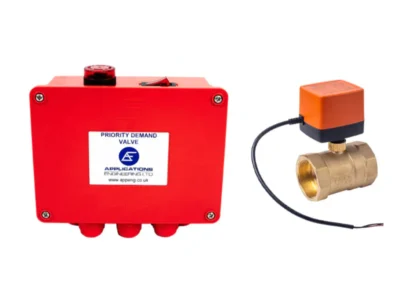Fire sprinkler systems play a critical role throughout winter as we rely more on heating systems than at any other time of the year. However, this can put them under extra stress and pressure as the risk of freezing increases and plummeting temperatures are a reason for concern.
So how can you maintain and protect your fire sprinkler system from freezing this winter? Let’s take a closer look!
Determine which type of sprinkler system you have
Before you can protect your fire sprinkler system from the elements, it’s important to figure out which type you have. There are two main types of fire sprinkler systems, they are:
- Wet sprinkler systems – hold water in their pipes, which are particularly vulnerable to freezing temperatures.
- Dry sprinkler systems – keep pressurised air in the pipes rather than water. Their pipes can withstand freezing temperatures, but their source pump cannot.
Regular maintenance
Whether you have a wet or dry fire sprinkler system, they both require regular maintenance to ensure they are working optimally. It is a good idea to arrange for an additional check for your fire sprinkler system from a professional as we approach the colder months to monitor their freeze protection status.
In particular, dry systems are harder to check because they aren’t filled with water, but condensation can form and then freeze inside the pipes. This may compromise the efficiency of the pressurised gas in the pipes, reducing the effectiveness of the fire sprinkler system when you need it most. Through the course of regular maintenance, any condensation can be checked for and dealt with before it becomes a potential obstruction in the pipes.
Heating sprinkler system enclosures
Typically, fire sprinkler pumps and control valves in dry systems are more sensitive to the temperature than their pipes. These are often housed in an enclosure that has automatic heating to maintain the perfect temperature and conditions.
It’s essential to check the thermostats in these enclosures are accurate as a drop in temperature may cause the fire sprinkler system to work sub-optimally. For enclosures built with a ventilation system, the environment must also be maintained for controlled airflow and louvres must not be locked in either open or closed positions.
Sprinkler pump house
Similarly, where a sprinkler system is served by fire pumps, the pumphouse must be kept in a temperature-controlled environment to work effectively. Those pumps using an electric motor must be maintained at 4 degrees Celsius while diesel pumps must be kept at a temperature no colder than 10 degrees Celsius.
Drainage of the sprinkler system
Although designed for deploying water rapidly, there can be areas in the pipework that are prone to water pooling. It’s therefore a critical part of fire sprinkler maintenance to drain the system before winter sets in to ensure no water is trapped in the pipework.
One reason why water may pool is due to damaged brackets that hold the pipes in place, altering the angle and reducing the effectiveness of the built-in drainage slopes. This is also the best opportunity to check for any damage to the pipes and repair them before refilling with water or gas.
Fire sprinkler valve systems you can trust
Here at Applications Engineering we supply high-quality fire sprinkler system products, such as Priority Demand Valves. We also specialise in the supply of mechanical switches and sensors fit for purpose across a wide range of industries.
From our Pressure Switches to Temperature
Share This Post




